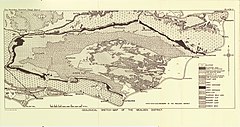Weald Clay
Geological formation in England From Wikipedia, the free encyclopedia
Weald Clay or the Weald Clay Formation is a Lower Cretaceous sedimentary rock unit underlying areas of South East England, between the North and South Downs, in an area called the Weald Basin. It is the uppermost unit of the Wealden Group of rocks within the Weald Basin, and the upper portion of the unit is equivalent in age to the exposed portion of the Wessex Formation on the Isle of Wight. It predominantly consists of thinly bedded mudstone.[1] The un-weathered form is blue/grey, and the yellow/orange is the weathered form, it is used in brickmaking.
| Weald Clay | |
|---|---|
| Stratigraphic range: Hauterivian-Barremian, | |
 Weald Clay exposed at Clock House Brickworks | |
| Type | Geological formation |
| Unit of | Wealden Group |
| Sub-units | Horsham Stone Member |
| Underlies | Atherfield Clay Formation |
| Overlies | Tunbridge Wells Sand Formation |
| Thickness | up to 460 m |
| Lithology | |
| Primary | Shale, Mudstone |
| Other | Siltstone, Sandstone, Limestone, Ironstone |
| Location | |
| Region | England |
| Country | UK |
| Type section | |
| Named for | Weald |
 Extent of the Weald Clay within the Weald Basin, shown with horizontal lines | |
The formation was deposited in lagoonal, lacustrine and alluvial conditions that varied from freshwater to brackish.[2] The clay alternates with other subordinate lithologies, notably hard red-weathering beds of ironstone, limestone (Sussex Marble) and sandstones, notably including the calcareous sandstone unit referred to as the Horsham Stone. It has a gradual, conformable contact with the underlying Tunbridge Wells Sand Formation, and has a sharp, unconformable contact with the overlying Atherfield Clay Formation, a shallow marine unit deposited after marine transgression during the Aptian.
Physical properties

The weathered and unweathered forms of the Weald Clay have different physical properties. Blue looks superficially like a soft slate, is quite dry and hard and will support the weight of buildings quite easily. Because it is quite impermeable, and so dry, it does not get broken by tree roots. It is typically found at 750mm down below a layer of yellow clay. Yellow, found on the surface, absorbs water quite readily so becomes very soft in the winter. The two different types make quite different bricks.
Paleofauna
Summarize
Perspective
Vertebrates
| Vertebrates reported from the Weald Clay | ||||||
|---|---|---|---|---|---|---|
| Genus | Species | Location | Stratigraphic position | Material | Notes | Images |
|
B. walkeri |
Smokejack Clay Pit | Upper Weald Clay |
Multiple partial skulls, one of which had an associated postcranial skeleton.[3] |
A spinosaurid |
 | |
|
H. rudgwickensis |
Rudgwick Brickworks | Upper Weald Clay |
"Vertebrae, partial fore and hindlimbs, osteoderms."[4] |
A dubious[5] genus of nodosaurid ankylosaur belonging to Polacanthinae. Originally named as a species of Polacanthus.[6] |
||
| Iguanodon | I. bernissartensis | Smokejack Clay Pit | Upper Weald Clay | Iguanodontian, also known from the Wessex Formation. |
 | |
| Mantellisaurus | M. atherfieldensis | Smokejack Clay Pit | Upper Weald Clay | Iguanodontian, also known from the Wessex Formation |
 | |
|
V. canaliculatus[7] |
Heathfield | Lower Weald Clay |
A dryosaurid, also known from the Wessex Formation |
|||
| Leptocleidus | L. superstes[8] | NHM R4828 (holotype) | Pliosauroid |
 | ||
| Wyleyia[9] | W. valdensis[9] |
|
||||
| Dorsetisaurus | Indeterminate | Keymer Tile Works | ||||
| Sauropoda | Indeterminate | Smokejacks, Bexhill | ||||
| Anura | Indeterminate | Keymer Tile Works | Lower | Maxillary fragment[10] | ||
| Urodela | Indeterminate | Keymer Tile Works | Lower | Atlas vertebra | Has been suggested to have a close relationship with Balveherpeton from Germany.[11] | |
Invertebrates
Numerous insect species are known from several localities in the Weald Clay, including Rudgwick Brickworks,[12] Auclaye Brickworks,[13] Smokejacks[14] and Clockhouse Brickworks[15][16][17]
| Invertebrates reported from the Weald Clay | ||||||
|---|---|---|---|---|---|---|
| Genus | Species | Location | Stratigraphic position | Material | Notes | Images |
| Principiala[18] | P. rudgwickensis | Rudgwick Brickworks | Upper Weald Clay | Single partial fore-wing | An Ithonidae lacewing, the second in Principiala | |
| Englathauma | E. crabbi | Rudgwick Brickworks | BMB 021962/3 almost complete forewing | A englathaumatid scorpionfly | ||
| E. mellishae | Smokejacks | Wing and wing fragments | ||||
| Cretophasmomima[19] | C. traceyae | Smokejacks | Forewing | A stick insect | ||
| Valdicossus | V. mikewebsteri[20] | Smokejacks | Upper | Hindwing | A member of Palaeontinidae | |
| V. chesteri[21] | Cooden Beach | Lower | Hindwing | |||
| Ilerdocossus | I. prowsei [20] | Clockhouse Brickworks | Lower | A member of Palaeontinidae | ||
| Proraphidia | P. hopkinsi[22] | A member of Mesoraphidiidae | ||||
| Turanophlebia | T. anglicana[23] | Dragonfly, member of Tarsophlebiidae | ||||
| Brochocoleus | B. keenani[24] B. tobini | Smokejacks | Upper | Member of Ommatidae | ||
| Diluticupes | D. crowsonae | |||||
| Zygadenia | Z. tuberculata,[25] Z. angliae[26] | |||||
| Cionocoleus | C. elizabethae, C. watsoni [27] C. minimus | |||||
| Omma | O. elongatum | Keymer Tile Works | Lower | |||
See also
Footnotes
References
Wikiwand - on
Seamless Wikipedia browsing. On steroids.
